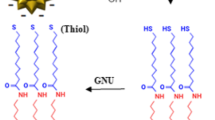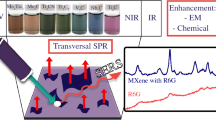Abstract
The layer-by-layer (LbL) method demonstrates significant versatility for constructing substrates with nanoscale-thick layers and diverse compositions. This technique is based on alternate deposition of species that interact electrostatically. Studies have demonstrated that this technique holds promise for use as a surface-enhanced Raman scattering (SERS) substrate, enabling the detection of pesticides at low concentrations and finding applications in the biological field. In this study, a simple methodology based on the layer-by-layer (LbL) method was developed to construct SERS substrates. Substrates with varying numbers of bilayers (1, 5, or 10) were built on glass slides. The positive layer was composed of the natural polysaccharide chitosan. In contrast, the negative layer consists of gold nanoparticles (AuNPs) with a negative charge on their surface, achieved using sodium citrate as a reducing agent. The SERS substrates were characterized by UV–VIS-NIR spectroscopy and atomic force microscopy (AFM). They were tested as SERS substrates by utilizing thiophenol (TP) at a concentration of 1.0 × 10–3 mol L−1. The distribution of the SERS signal was monitored through the 417 cm−1 peak, which is attributed to the CH stretching mode characteristic of TP. The substrates exhibited a more significant enhancement with an increase in the number of bilayers. They have proven highly promising for future applications, such as diagnostic evaluation of diseases, detection of pesticide molecules, biological molecules, and various other applications.




Similar content being viewed by others
Data availability
Data will be available upon request to the corresponding authors. Available data include Raman spectra, Raman spectra used to creat the SERS mappings and original microscopy files.
References
Amendola V, Pilot R, Frasconi M, et al (2017) Surface plasmon resonance in gold nanoparticles: a review. J Phys Condens Matter 29. https://doi.org/10.1088/1361-648X/aa60f3
Kumar A, Kim S, Nam JM (2016) Plasmonically engineered nanoprobes for biomedical applications. J Am Chem Soc 138:14509–14525. https://doi.org/10.1021/jacs.6b09451
Langer J, Novikov SM, Liz-Marzán LM (2015) Sensing using plasmonic nanostructures and nanoparticles. Nanotechnology 26. https://doi.org/10.1088/0957-4484/26/32/322001
Jeevanandam J, Barhoum A, Chan YS et al (2018) Review on nanoparticles and nanostructured materials: history, sources, toxicity and regulations. Beilstein J Nanotechnol 9:1050–1074. https://doi.org/10.3762/bjnano.9.98
Guo Q, Xu M, Yuan Y et al (2016) Self-assembled large-scale monolayer of Au nanoparticles at the air/water interface used as a SERS substrate. Langmuir 32:4530–4537. https://doi.org/10.1021/acs.langmuir.5b04393
Cardinal MF, Vander Ende E, Hackler RA et al (2017) Expanding applications of SERS through versatile nanomaterials engineering. Chem Soc Rev 46:3886–3903. https://doi.org/10.1039/c7cs00207f
Reguera J, Langer J, Jiménez De Aberasturi D, Liz-Marzán LM (2017) Anisotropic metal nanoparticles for surface enhanced Raman scattering. Chem Soc Rev 46:3866–3885. https://doi.org/10.1039/c7cs00158d
Fan M, Andrade GFS, Brolo AG (2020) A review on recent advances in the applications of surface-enhanced Raman scattering in analytical chemistry. Anal Chim Acta 1097:1–29. https://doi.org/10.1016/J.ACA.2019.11.049
Avci E, Culha M (2013) Influence of droplet drying configuration on surface-enhanced Raman scattering performance. RSC Adv 3:17829–17836. https://doi.org/10.1039/C3RA42838A
Iler RK (1966) Multilayers of colloidal particles. J Colloid Interface Sci 21:569–594. https://doi.org/10.1016/0095-8522(66)90018-3
Kirkland JJ (1965) Porous thin-layer modified glass bead supports for gas liquid chromatography. Anal Chem 37:1458–1461. https://doi.org/10.1021/ac60231a004
Richardson JJ, Björnmalm M, Caruso F (2015) Technology-driven layer-by-layer assembly of nanofilms. Science (1979) 348. https://doi.org/10.1126/science.aaa2491
Ariga K, Yamauchi Y, Rydzek G et al (2014) Layer-by-layer nanoarchitectonics: invention, innovation, and evolution. Chem Lett 43:36–68. https://doi.org/10.1246/cl.130987
de Oliveira DG, Peixoto LPF, Sánchez-Cortés S, Andrade GFS (2016) Chitosan-based improved stability of gold nanoparticles for the study of adsorption of dyes using SERS. Vib Spectrosc 87. https://doi.org/10.1016/j.vibspec.2016.08.017
de Oliveira DG, Pimentel GA, Andrade GFS (2020) Chitosan stabilization and control over hot spot formation of gold nanospheres and SERS performance evaluation. Vib Spectrosc 110:103119. https://doi.org/10.1016/j.vibspec.2020.103119
Águila-Almanza E, Low SS, Hernández-Cocoletzi H et al (2021) Facile and green approach in managing sand crab carapace biowaste for obtention of high deacetylation percentage chitosan. J Environ Chem Eng 9:105229. https://doi.org/10.1016/j.jece.2021.105229
Garcia-Hernandez C, Freese AK, Rodriguez-Mendez ML, Wanekaya AK (2019) In situ synthesis, stabilization and activity of protein-modified gold nanoparticles for biological applications. Biomater Sci 7:2511–2519. https://doi.org/10.1039/C9BM00129H
Zhang S, Xu Z, Guo J et al (2021) Layer-by-layer assembly of polystyrene/Ag for a highly reproducible SERS substrate and its use for the detection of food contaminants. Polymers (Basel) 13:3270. https://doi.org/10.3390/polym13193270
Deng ZJ, Morton SW, Ben-Akiva E et al (2013) Layer-by-layer nanoparticles for systemic codelivery of an anticancer drug and siRNA for potential triple-negative breast cancer treatment. ACS Nano 7:9571–9584. https://doi.org/10.1021/nn4047925
Jiang Y, Sun D, Liang Z et al (2018) Label-free and competitive aptamer cytosensor based on layer-by-layer assembly of DNA-platinum nanoparticles for ultrasensitive determination of tumor cells. Sens Actuators B Chem 262:35–43. https://doi.org/10.1016/j.snb.2018.01.194
Rizwan M, Elma S, Lim SA, Ahmed MU (2018) AuNPs/CNOs/SWCNTs/chitosan-nanocomposite modified electrochemical sensor for the label-free detection of carcinoembryonic antigen. Biosens Bioelectron 107:211–217. https://doi.org/10.1016/j.bios.2018.02.037
Rodrigues VC, Moraes ML, Soares JC et al (2018) Immunosensors made with layer-by-layer films on chitosan/gold nanoparticle matrices to detect D-dimer as biomarker for venous thromboembolism. Bull Chem Soc Jpn 91:891–896. https://doi.org/10.1246/bcsj.20180019
Li J, Khalenkow D, Volodkin D et al (2022) Surface enhanced Raman scattering (SERS)-active bacterial detection by Layer-by-Layer (LbL) assembly all-nanoparticle microcapsules. Colloids Surf A Physicochem Eng Asp 650:129547. https://doi.org/10.1016/j.colsurfa.2022.129547
Frens G, Kolloid Z (1973) Controlled nucleation for the regulation of the particle size in monodisperse gold suspensions. Nat Phys Sci 241:20–22. https://doi.org/10.1038/246421a0
Holze R (2015) The adsorption of thiophenol on gold – a spectroelectrochemical study. Phys Chem Chem Phys 17:21364–21372. https://doi.org/10.1039/C5CP00884K
Peixoto LPF, Santos JFL, Andrade GFS (2019) Plasmonic nanobiosensor based on Au nanorods with improved sensitivity: a comparative study for two different configurations. Anal Chim Acta 1084:71–77. https://doi.org/10.1016/j.aca.2019.07.032
Rechberger W, Hohenau A, Leitner A et al (2003) Optical properties of two interacting gold nanoparticles. Opt Commun 220:137–141. https://doi.org/10.1016/S0030-4018(03)01357-9
Bohn JE, Le Ru EC, Etchegoin PG (2010) A statistical criterion for evaluating the single-molecule character of SERS signals. J Phys Chem C 114:7330–7335. https://doi.org/10.1021/jp908990v
De Albuquerque CDL, Sobral-Filho RG, Poppi RJ, Brolo AG (2018) Digital protocol for chemical analysis at ultralow concentrations by surface-enhanced raman scattering. Anal Chem 90:1248–1254. https://doi.org/10.1021/acs.analchem.7b03968
Peixoto L, Santos J, Andrade G (2019a) Plasmonic biosensors based on surface-enhanced Raman scattering using gold nanorods. Quim Nova 42:1050–1055. https://doi.org/10.21577/0100-4042.20170416
Acknowledgements
The authors thank FAPEMIG, CNPq, and CAPES (financing code 001) for financial support. LPFP thanks CAPES for a fellowship, and PHMT thanks FAPEMIG for a fellowship. The authors thank ‘INMETRO – Divisão de Metrologia de Materiais’ for accessing the AFM facility and the Brazilian Company of Agricultural Research (EMBRAPA) Dairy Cattle for ζ-potential measurements.
Funding
This study was funded by the Brazilian funding agencies: “Fundação de Amparo à Pesquisa do Estado de Minas Gerais,” FAPEMIG, grant APQ-00887–23; “Conselho Nacional de Desenvolvimento Científico e Tecnológico,” CNPq, grants 406853/2021–5 and 311958/2021–4; and “Coordenação de Aperfeiçoamento de Pessoal de Nível Superior,” CAPES, financing code 001.
Author information
Authors and Affiliations
Contributions
PHMT and LPFP performed the experiments on the deposition of materials and spectroscopy. PHMT wrote the initial draft. LPFP worked on the first steps of revision of the manuscript. BF performed the probe microscopy experiments and discussed the data. GFSA discussed data, acquired funding, and supervised the experiments. All the authors reviewed and discussed the manuscript in several iterations.
Corresponding authors
Ethics declarations
Ethical approval
Not applicable.
Competing interests
The authors declare no competing interests.
Additional information
Publisher's Note
Springer Nature remains neutral with regard to jurisdictional claims in published maps and institutional affiliations.
Supplementary information
Below is the link to the electronic supplementary material.
Rights and permissions
Springer Nature or its licensor (e.g. a society or other partner) holds exclusive rights to this article under a publishing agreement with the author(s) or other rightsholder(s); author self-archiving of the accepted manuscript version of this article is solely governed by the terms of such publishing agreement and applicable law.
About this article
Cite this article
de Melo Toledo, P.H., de Faria Peixoto, L.P., Fragneaud, B. et al. Layer-by-layer chitosan and gold nanoparticles as surface-enhanced Raman scattering substrate. J Nanopart Res 26, 74 (2024). https://doi.org/10.1007/s11051-024-05982-9
Received:
Accepted:
Published:
DOI: https://doi.org/10.1007/s11051-024-05982-9




